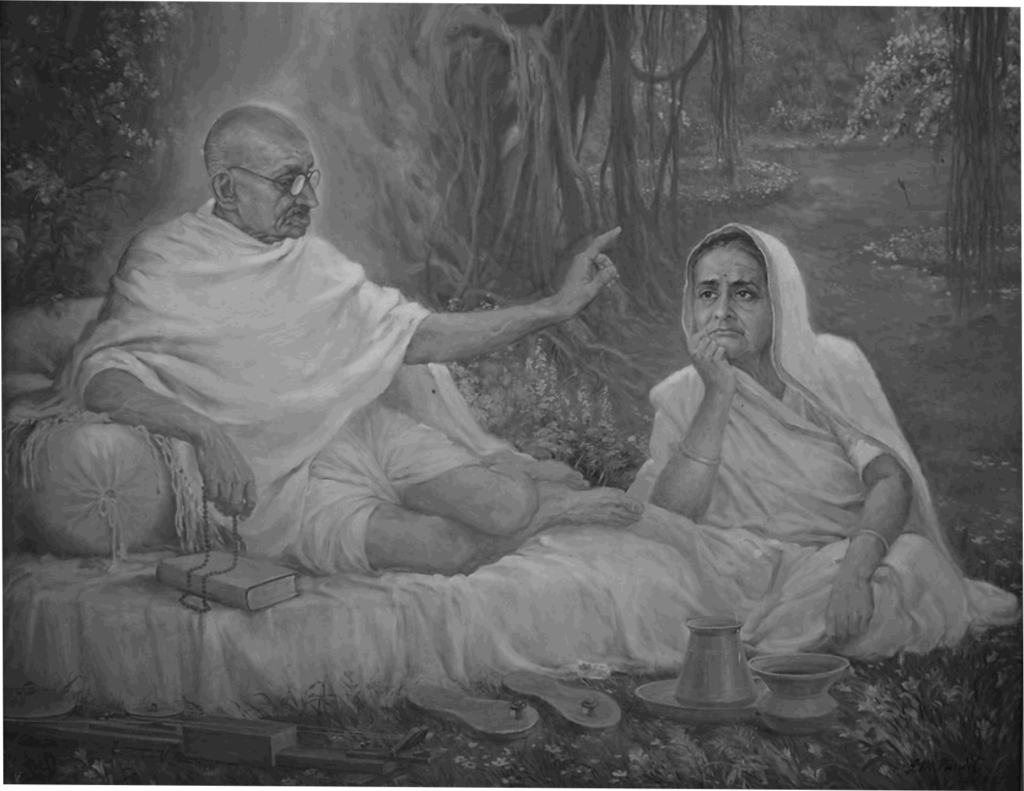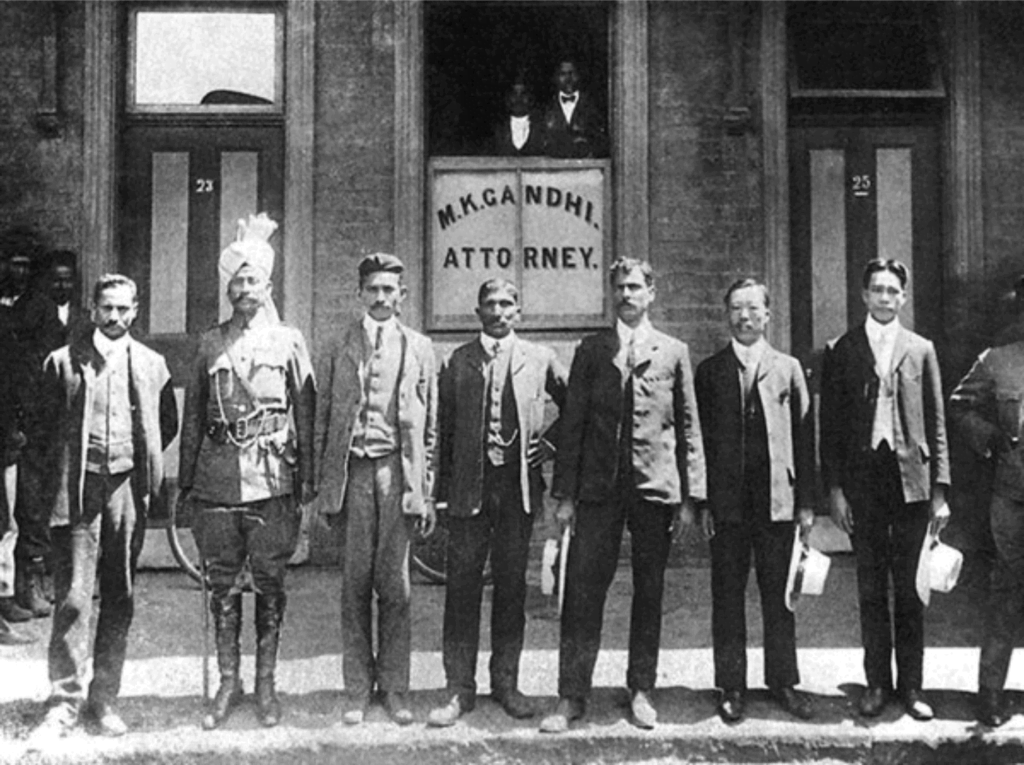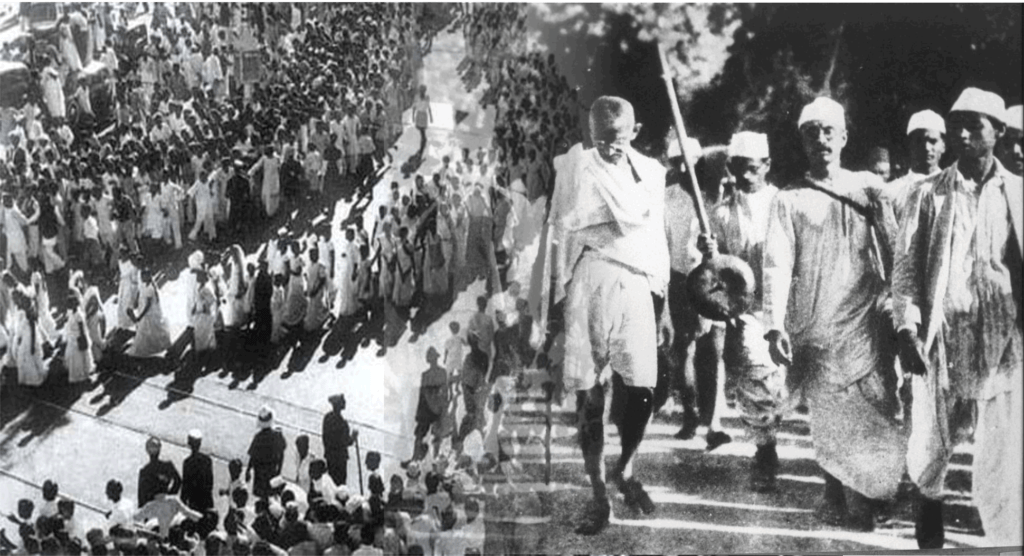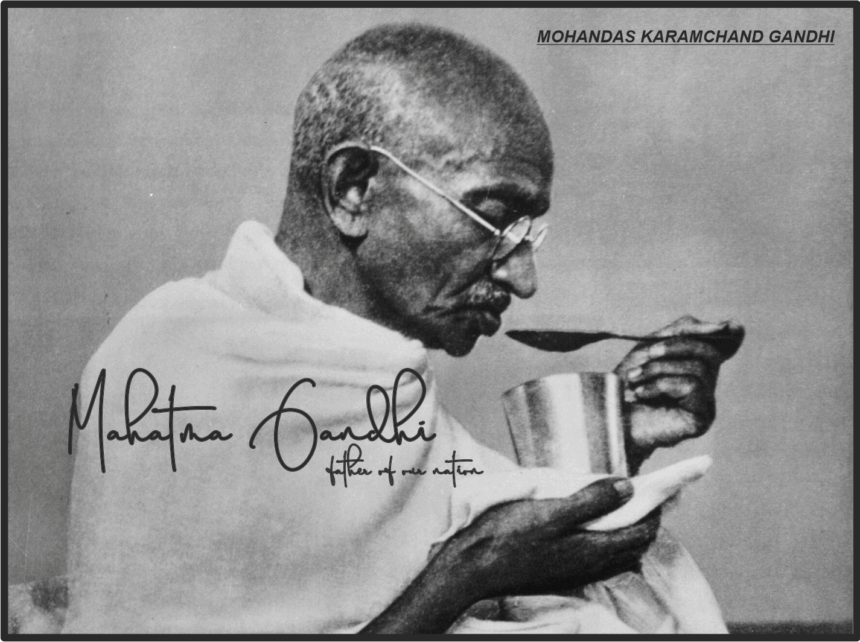Mahatma Gandhi’s Biography- Journey to Freedom
Every time we debate the history of our nation, India, we undoubtedly bring up the liberation struggle and the fighters who made significant contributions to it. Learn more about India’s liberation fighters here. In this quest for liberation, there were two kinds of fighters.
First – Chandrashekhar Azad, Sardar Bhagat Singh, and other notable individuals were among those who desired to retaliate to the horrors carried out by the British by also bleeding blood.
Second – There were other types of fighters -: Those who wished to provide freedom to the country by travelling on the path of peace instead of this terrible scenario, the most important name among them is -: Mahatma Gandhi. People began referring to him as ‘Mahatma’ because of his attitude of upholding truth, peace, and nonviolence.
| Name | Mohandas Karamchand Gandhi |
| Father’s Name | Karamchand Uttamchand Gandhi |
| Mother’s Name | Putlibai |
| Wife’s Name | Kasturbai Mohandas Gandhi (born Kasturbai Gokuldas Kapadia) |
| Date of Birth | October 2, 1869 |
| Place of Birth | Porbandar region of Gujarat |
| Nationality | Indian |
| Religion | Hindu |
| Caste | Gujarati |
| Education | Barrister |
| Name of Children | Harilal, Manilal, Ramdas, Devdas |
| Died | 30 January 1948 |
| Name of the Killer | Nathuram Godse |
Mahatma Gandhi’s Birth & Family Tree India’s Gujarat state is home to Gandhi Ji’s birthplace, Porbandar. His mother Putlibai was a devout woman, and his father Mr. Karamchand Gandhi was the ‘Diwan’ of Porbandar. Gandhiji was descended from Gujarati parents. Kasturba Gandhi was his wife’s name. Mahatma Gandhi had four children: Devdas, Ramdas, Manilal, and Harilal.

Mahatma Gandhi (Early Stage)
Gandhiji’s life was greatly influenced by his mother. At thirteen, he tied the knot, and Kasturba was fourteen. After passing his matriculation test in November 1887, he joined in Samaldas College, Bhavnagar, in January 1888 studied here and received a degree. Then he go to London where he completed his Law degree and became barrister and returned.
Mahatma Gandhi visited to South Africa
Gandhiji travelled to South Africa in 1894 as part of a court case, when he began a “Disobedience Movement” against the injustice that was taking on. After the movement was finished, he left for India.

Mahatma Gandhi’s Struggle Freedom of India
After Gandhiji returned to India from South Africa in 1916, he began to work towards the nation’s freedom. Gandhiji served as the Congress’s leader following the passing of prominent Congressman Bal Gangadhar Tilak in 1920.
Gandhiji provided the British Government with complete assistance during the First World War (1914–1919), provided that he would then liberate India. But Gandhiji began a number of movements to secure the nation’s independence when the British failed to take this action. Here are a few of these motions:
- Non-Co-operation Movement in 1920
- Civil Disobedience Movement in 1930
- Quit India Movement in 1942
Gandhiji’s life was, incidentally, a movement throughout. However, he was mostly responsible for 5 movements, 3 of which were nationwide and extremely successful, which is why people also preserve records of them.
All of these movements led by Gandhiji can be categorized as follows:
- In 1918: Champaran and Kheda Satyagraha
- In 1919: Khilafat Movement·
- In 1920: Non-Cooperation Movement·
- In 1930: Civil Disobedience Movement / Dandi March
- In 1942: Quit India Movement
Champaran and Kheda Satyagraha in 1918
Gandhiji’s campaigns in India began with the “Champaran and Kheda Satyagraha,” which he successfully led in 1918. The British landowner was the target of this Satyagraha. These British landlords were pressuring the Indian farmers to grow indigo, even to the point where they were forcing them to sell it for a certain price, which the Indian farmers found objectionable. Then he enlisted Mahatma Gandhi’s assistance.

Gandhiji then launched a nonviolent campaign on this issue, was successful in it, and forced the British to heed him. The farmers in the Gujarat province’s village of Kheda were unable to pay the British government’s tax since the village had flooded that same year. Subsequently, he sought assistance from Gandhiji, who employed the tactic of “non-cooperation” to push for farmers to be excluded from paying taxes. Gandhiji received a great deal of public support for this cause, and in May 1918 the British government was forced to declare that its tax-related regulations would be relaxing for farmers.
Khilafat Movement in 1919
Gandhiji began to notice in 1919 that the Congress was beginning to wane, so he made an effort to turn the Congress around while also using Hindu-Muslim solidarity to overthrow the British administration. commenced it. He went to the Muslim society in order to achieve these goals. An international movement known as the Khilafat Movement was started in opposition to the Muslim Caliph. The nation’s Muslims gathered for a convention that Mahatma Gandhi organised. [All India Muslim Conference], and he was the focal point of this gathering as well. Gandhiji’s efforts in this struggle helped the Muslims much, and they also earned him a special place in the Congress and the title of national leader.

However, the Khilafat movement came to a disastrous end in 1922. Gandhiji continued to strive for “Hindu-Muslim unity” for the rest of his life, but the gap between Muslims and Hindus only grew.
What is Non-Cooperation Movement in 1920
In 1919, the British government enacted the Rowlett Act in response to a number of movements. Gandhiji also arranged some meetings during this period, and similar to those gatherings, other gatherings were arranged at various locations. A similar gathering took place in the Punjabi district of Amritsar in Jallianwala Bagh, and Gandhiji launched the non-cooperation campaign in 1920 in response to the British government’s ruthless crushing of this peace conference. This movement of non-cooperation meant that Indians should not provide any kind of assistance to the British government. However, this should not involve any violence of any kind. September 1920 saw the beginning of this movement, which lasted until February 1922. Of the three great movements that Gandhiji started, this was the first.
The idea behind Mahatma Gandhi’s movement was that the British government can only rule India because the Indian people support them. If this support were to cease, the British government would find it more difficult to rule the Indian people. Gandhiji therefore made an appeal to the people to refrain from cooperating with the British government in any capacity, provided that this cooperation did not involve any form of violent activity. Gandhiji’s statements were comprehended and accepted by the public as true. A significant number of people nationwide joined the campaign and ceased collaborating with the British government. People quit their employment in the government, factories, offices, etc. because of this. Parents pulled their kids out of public universities and schools. That is, every effort was taken to ensure that the British received no assistance at all. However, as a result, a large number of people had fallen into poverty and illiteracy, but they persisted in enduring all of this in exchange for their nation’s freedom. The atmosphere at the moment made it possible that we wouldn’t have gained independence until then. However, Gandhiji chose to put an end to the movement during its height because of the occurrence at a location called “Chaura-Chauri.
What is “Chauri Chaura” Incident
Since the non-cooperation campaign was being carried out peacefully throughout the nation, at one point some people were holding a peaceful protest in the Uttar Pradesh state at a location named Chaura Chauri. Suddenly, the British soldiers opened fire on them, killing a number of people that fatalities also occurred there. Then, this enraged crowd slaughtered 22 soldiers who were present at the police station by setting it on fire. Gandhiji then stopped the movement due to the violent behaviour, stating that “we did not have to do any violent activity during the entire movement, perhaps we are not yet fit to get freedom.
What is Civil Disobedience Movement or Dandi March or Salt Satyagraha Movement
Mahatma Gandhi launched yet another anti-British crusade in 1930. This movement was known as the Civil Disobedience Movement. This movement did not exist to follow or disobey any laws or decrees issued by the British government. For example, he began his ‘Dandi Yatra’ on March 12, 1930, in defiance of a British government regulation prohibiting anyone from producing salt. This movement was also carried out peacefully because they arrived at a location called Dandi and manufactured salt there. The British government detained numerous leaders during this time.
Details
Gandhiji began the Civil Disobedience Movement on March 12, 1930, from Sabarmati Ashram, which is close to Ahmedabad, Gujarat. The movement continued till April 5, 1930, to a location in Gujarat known as Dandi. Gandhiji disregarded this prohibition and manufactured salt after arriving here, which sparked the beginning of the national Civil Disobedience Movement. In the fight for Indian independence, this was a crucial stage. This campaign quickly spread across the nation as a direct challenge to the British government’s monopoly on the production of salt. ‘Purna Swaraj’ was also launched by the Indian National Congress on January 26, 1930, at the same time. m.] had determined the distance. Mahatma Gandhi finished the Dandi March in 24 days, travelling around 390 km from Sabarmati to Dandi. Here he produced salt without of taxes. There were 78 supporters with him when he started this voyage, and by the time it was over, there were thousands of them. He arrived here on April 5, 1930, at 6.30 at morning that same day, he began a successful nonviolent civil disobedience movement against the British government by producing salt, with the help of thousands of Indians.
After producing salt here, Mahatma Gandhi carried on with his tour and headed southward towards the beaches. Not only was his goal to create salt on these beaches, but he was also trying to address numerous meetings at the same time. Here, at a location known as Dharasana, he also disobeyed this commandment. At midnight on May 4-5, 1930, Gandhiji was taken into custody. His detention and this Satyagraha brought India’s freedom movement to the attention of people worldwide. Gandhiji’s release from prison marked the end of this year-long Satyagraha, which was made possible by Viceroy Lord Irwin’s agreement to negotiate during the Second Round Table Conference. As a result of this Salt Satyagraha, almost 80,000 people were arrested.
The foundation of Gandhiji’s Salt Satyagraha was his ‘non-violent protest’ philosophy. Its exact definition is satyagraha, or the emphasis upon truth. Gandhiji was named as the chief of the Satyagraha, which the Congress used as a weapon to secure India’s independence. Thousands of people were slain by the English army during the Satyagraha in Dharsana as a result, but in the end, Gandhiji’s Satyagraha strategy worked, and the British government was forced to concede. Martin Luther King, James Bevel, and other American activists were greatly influenced by this satyagraha. those who, in the 1960s, battled against the apartheid policy—which discriminated against Black and White people—and for the rights of minorities. As the satyagraha and disobedience campaign grew, it was given to Khan Abdul Ghaffar Khan in North India and Rajagopalachari in Madras for appropriate leadership.
Quit India Movement in 1942
Children and young people throughout the nation were fervently passionate about India’s independence in the 1940s. Gandhiji then directed its usage to great effect, launching the Quit India Movement on a massive scale in 1942. Out of all the motions so far, this one was the most efficient. The British government faced a great problem in this regard.
Details
The Quit India Movement was Mahatma Gandhi’s third significant movement, started in 1942. Mahatma Gandhi launched it in August 1942. However, as a result of operational errors, this movement quickly came to an end, proving that it was unsuccessful. Many factors contributed to its failure, including the following: Farmers, students, and others were involved in the campaign, and word of it spread widely among them; however, the movement did not begin at the same time across the nation. Commencing on different days lessened its impact. In addition, a lot of Indians believed that the liberation struggle had reached its pinnacle and that freedom would soon arrive, which undermined the campaign. One positive outcome of this movement, however, was that the British rulers realised they would have to leave India either today or tomorrow if they wanted to continue ruling the country. In this sense, every action that Gandhiji led during his lifetime made a significant contribution to our nation’s liberation.
Points to remember of such movements.
Throughout all of Mahatma Gandhi’s movements, a few elements remained constant; these are the specifics:
- There was always a peaceful approach to these movements.
- If there was any aggressive behavior’s during the movement, Gandhiji called it quits. This contributed to the fact that we gained independence a little later than expected.
- Truth and non-violence have always served as the cornerstones of movements.
Social life of Mahatma Gandhi
Not only was Gandhiji a fantastic leader, but he also adhered to the philosophy of “simple living and high thinking” in his social interactions. People began calling him ‘Mahatma’ because of his nature. Gandhiji had a strong belief in democracy. ‘Truth and non-violence’ were his two weapons. With the use of these weapons, he freed India from British rule. Gandhiji had such a charisma that he used to influence everyone he came into contact with.
Abolition of Untouchability
Gandhiji made a lot of efforts to eradicate the societal perception that people are untouchable. In the name of God, he gave those of lower caste the name “Hari-Jan” and continued working towards their advancement till the end of his life.
Age and Death of Mahatma Gandhi
On January 30, 1948, Mahatma Gandhi was shot and killed by Nathuram Godse. “Hey Ram,” was his last words after being shot three times. After his death, a mausoleum was built in RajGhat in Delhi. Mahatma Gandhi left, saying goodbye to his countrymen at the age of 79.
Facts about Gandhiji
- Although Subhash Chandra Bose referred to Mahatma Gandhi as the Father of the Nation on Singapore Radio on July 6, 1944, the Indian government never officially recognized him as such. Sarojini Naidu referred to him as the “Father of the Nation” on April 28, 1947. Another name for Mahatma Gandhi is Bapu. (it’s a loving term for “father” in Gujarati) During the funeral service for Gandhiji, Minister Nehru called him Bapu.
- An English officer stated after Gandhiji’s passing that “the Gandhi whom we did not allow anything to happen for so many years, so that the atmosphere against us in India does not get worse, that Gandhi did not live even for a year in independent India.” may always be.
- Gandhiji also started the Swadeshi campaign, calling on everyone to boycott foreign products. In order to produce Swadeshi clothing and other items, he also operated a charkha and produced fabric.
- Gandhiji also founded a number of ashrams both domestically and outside, two of which gained notoriety: Tolstoy Ashram and Sabarmati Ashram in India.
- Gandhiji used to undertake extremely challenging fasts in order to purify his soul.
- Throughout his life, Gandhiji worked for Hindu-Muslim reconciliation.
- On October 2, the birthday of Gandhiji, Gandhi Jayanti is observed throughout India. Gandhiji was a truly wonderful guy in this regard. Gandhiji accomplished a lot throughout his life, but his greatest asset was his commitment to “truth and non-violence.” By following his teachings, we may still make significant social improvements in the modern world.
FAQs: Mahatma Gandhi’s Biography- Journey to Freedom
- What role did Mahatma Gandhi play in India’s struggle for independence?
Mahatma Gandhi was a central figure in India’s fight for independence, employing non-violent civil disobedience to challenge British rule. - How did Gandhi’s philosophy of truth and non-violence impact his movements?
Gandhi’s philosophy of truth and non-violence served as the cornerstone of his movements, emphasizing peaceful resistance and the pursuit of truth. - What were the key movements led by Mahatma Gandhi, and how did they contribute to India’s freedom?
Gandhi led several movements, including the Non-Cooperation Movement, Civil Disobedience Movement, and Quit India Movement, each playing a crucial role in India’s journey to freedom. - How did Mahatma Gandhi approach the issue of untouchability in Indian society?
Gandhi actively worked to eradicate untouchability, renaming those of lower caste as “Harijans” and advocating for their social advancement. - What were the outcomes of the Champaran and Kheda Satyagraha movements led by Gandhi?
The Champaran and Kheda Satyagraha movements were successful nonviolent campaigns addressing issues faced by Indian farmers, showcasing the power of peaceful resistance. - What led to the end of the Quit India Movement in 1942, and what impact did it have on the British government?
The Quit India Movement faced operational challenges and ended prematurely. However, it signaled to the British government that the struggle for independence was gaining momentum. - How did Mahatma Gandhi’s principles influence his social interactions and leadership style?
Gandhi adhered to a philosophy of “simple living and high thinking,” promoting democracy, truth, and non-violence in his social interactions and leadership. - What were the significant contributions of Mahatma Gandhi to Hindu-Muslim unity, and why did the Khilafat Movement come to an end?
Gandhi’s efforts for Hindu-Muslim unity were reflected in the Khilafat Movement, which aimed to overthrow British rule. However, the movement concluded in 1922 without achieving its goals. - How did Mahatma Gandhi’s Salt Satyagraha movement impact the fight for Indian independence?
The Salt Satyagraha movement, marked by the Dandi March, challenged the British monopoly on salt production and brought global attention to India’s struggle for freedom. - What were Mahatma Gandhi’s last words, and how did his assassination impact the nation?
Mahatma Gandhi’s last words were “Hey Ram.” His assassination on January 30, 1948, by Nathuram Godse had a profound impact on the nation, marking the end of an era.


